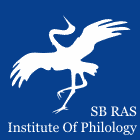 |
|
||||||||||||
|
Institute of Philology of
the Siberian Branch of Russian Academy of Sciences |
|
||||||||||||
|
|||||||||||||
| Sibirskii Filologicheskii Zhurnal (Siberian Journal of Philology) | |
|
Article
Authors: Oksana A. Kolmakova Irkutsk State University, Irkutsk, Russian Federation In the section Study of literature
Abstract: This paper explores the mythological and folkloric imagery present in Andrei Igumnov’s 2003 novel, “Bubbles of Life.” This classic postmodern novel has its artistic world shaped by a triad of irony, playfulness, and intertextuality. The narrative structure of the text is characterized by an intricate interweaving of elements drawn from folklore, Christianity, and archaic mythology, with literary allusions and sociocultural commentary, all framed within a ludic poetic style. The narrative is structured around three interconnected plotlines. The first is the historical development of a city in the Central Siberian Uplands. The second is the fate of a generation born in the 1990s. And the third is the intrusion of an alternate reality into the life of a person. These threads are unified by the figure of the protagonist, Peter Andreevich Sabashnikov, whose image is encoded in a multifaceted manner. Typologically, the origins can be traced back to the archetype of “the hero of our time.” This archetype is characterized by the preservation of moral integrity, despite the internalization of the inconsistencies prevalent during the given historical period. This image represents an individual who has a genuine personality and who consciously and voluntarily accepts responsibility for the evil happening in the world. In the final scene of the novel, Igumnov presents a utopian “communitas” of seven individuals, evoking Victor Turner’s concept. The writer challenges the prevailing axiological framework of the modern world. A contrast is drawn between the values of modern society (social stratification, materialism, and a focus on pleasure) and the overarching humanistic principles of family, work, and a life integrated with nature. Keywords: modern Russian prose, A. G. Igumnov, the novel “Bubbles of Life”, myth, folklore, the archetype, the image, the motif Bibliography: Baudrillard J. Simvolicheskiy obmen i smert’ [Symbolic exchange and death]. Mos-cow, Dobrosvet, 2000, 387 p. Bergson H. Dva istochnika morali i religii [Two sources of morality and religion]. Moscow, Kanon, 1994, 384 p. Bibliya: Knigi Svyashchennogo pisaniya Vetkhogo i Novogo Zaveta [Bible: Books of the Holy Scriptures of the Old and New Testament]. Moscow, Bibleyskie obshchestva, 1995, 1376 p. Buyda Yu. V. Vor, shpion i ubiytsa: roman [Thief, spy, and murderer: a novel]. Moscow, Eksmo, 2014, 320 p. Byliny pro starogo kazaka Il’yu Muromtsa: svodnyy tekst [Bylinas about the old Cossack Ilya Muromets: summarized text]. A. S. Mironov (Comp.). Moscow, Institut Naslediya, 2024, 426 p. Chernov A. V. Arkhetip “bludnogo syna” v russkoy literature 19 veka [Archetype of the ‘prodigal son’ in Russian literature of the 19th century]. In: Evangel’skiy tekst v russkoy literature 18–20 vv. [The Gospel text in Russian literature of the 18th – 20th centuries]. Petrozavodsk, PetrSU, 1994, pp. 150–157. Gurevich P. S. Problema tselostnosti cheloveka: monografiya [The problem of hu-man integrity: a monograph]. Moscow, Institute of Philosophy RAS, 2004, 178 p. Imikhelova S. S. Mozaika natsional’noy zhizni: o literaturnom protsesse v Buryatii (2010-e gody): monografiya [Mosaic of national life: on the literary process in Buryatia (2010s): a monograph]. Ulan-Ude, BSU, 2020, 216 p. Jung C. G. Dusha i mif. Shest’ arkhetipov [The archetypes and the collective uncon-scious]. Kiev, Gos. biblioteka Ukrainy dlya yunoshestva, 1996, 384 p. Lebedushkina O. Pro lyudei i nelyudei [About people and non-people]. Druzhba narodov. 2006, no. 1, pp. 190–198. Lévi-Strauss C. Pervobytnoe myshlenie [Primitive thinking]. Moscow, TERRA – Knizhnyy klub, Respublika, 1999, 392 p. Levkievskaya E. Mify russkogo naroda [Myths of the Russian people]. Moscow, Astrel’, ACT, 2000, 528 p. Losev A. F. Dialektika mifa [Dialectics of Myth]. St. Petersburg, Azbuka, Azbuka-Atticus, 2014, 320 p. Propp V. Ya. Morfologiya skazki [Morphology of the fairy tale]. Moscow, Nauka, 1969, 168 p. Russkie narodnye skazki A. N. Afanas’eva: V 5 t. [Russian folk tales by A. N. Afanasyev: in 5 vols.]. Moscow, Tip. Tov. I. D. Sytina, 1914, vol. 3, 293 p. Solzhenitsyn A. I. Rossiya v obvale [Russia in the collapse]. Moscow, Russkiy put’, 2009, 208 p. Tarmakhanov A. Tektonicheskaya proza Andreya Igumnova: Rets. na kn.: Igum-nov A. Puzyri zhizni [Tectonic prose of Andrei Igumnov: Review of the book: Igumnov A. Bubbles of life]. Novaya Buryatiya. 2010, August 23, p. 11. Turner V. Simvol i ritual [Symbol and Ritual]. Moscow, Nauka, 1983, 277 p. Tyupa V. I., Romodanovskaya E. К. Slovar’ motivov kak nauchnaya problema [Dictionary of motifs as a scientific problem]. In: Materialy k “Slovaryu syuzhetov i motivov russkoy literatury”: ot syuzheta k motivu [Materials for the “Dictionary of plots and motifs of Russian literature”: from plot to motif]. Tyupa V. I. (Ed.). Novosi-birsk, Institute of Philology SB RAS, 1996, pp. 3–15. |
 |
Institute of Philology Nikolaeva st., 8, Novosibirsk, 630090, Russian Federation +7-383-330-15-18, ifl@philology.nsc.ru |
© Institute of Philology |


